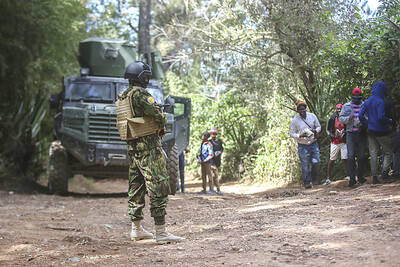The commander of the unit charged with abusing prisoners at Abu Ghraib testified on Thursday that the prison's top military intelligence officer was in the cellblock the night a prisoner died during interrogation, suggesting that the officer, Colonel Thomas Pappas, was aware of efforts to conceal the death.
Testifying at a hearing for one of the seven accused members of his unit, the 372nd Military Police Company, Captain Donald Reese said that one night last November he saw the bloodied body of an Iraqi prisoner who had died during interrogation inside a shower stall in a prison cellblock. He said a number of officers were standing around the body, discussing what to do.
One of them, he said, was Pappas, the prison's military intelligence chief. "I heard Colonel Pappas say, `I'm not going to go down alone for this,'" Reese testified. An autopsy the next day established the cause of death as a blood clot from trauma, he said.
The hearing was for Specialist Sabrina Harman, 26, who appears in some of the photographs of the prisoner abuse at Abu Ghraib showing a human pyramid of detainees. Harman also appears smiling broadly in a photograph with the dead detainee referred to in Reese's testimony. She has been charged with conspiracy, dereliction of duty, cruelty and maltreatment, making a false statement and assault.
In addition to Pappas, Reese testified that among the others in the room were members of the CIA.
Reese, whose testimony lasted several hours, said he had been told the detainee had died from "a heart attack." But, he said, the body was "bleeding from the head, nose, mouth."
The testimony appears to be the first to suggest that a senior officer was aware of a suspicious death immediately after it happened, and that he was involved in or knew of attempts to hide it. The testimony also offered a wealth of details on the case, from a request for ice to preserve the detainee's body to an attempt to spirit it out of the prison connected to a false intravenous drip to make it appear that the dead man was simply ill.
Reese testified that the detainee had died during interrogation.
"He died in the shower," Reese said. "I was told that when he was brought in he was combative, that they took him up to the room and during the interrogation he passed [died]."
He said he was told the body "was taken to Baghdad some-where."
A US military policeman said in sworn testimony in April that the man had been brought to Abu Ghraib by OGA, initials for "other government agency," or the CIA.
In his testimony, Reese described the generally abusive atmosphere at the prison. On his first day there, he said, he noticed Iraqi inmates with underwear on their heads. Another inmate, he said, was wearing a plastic food container as underwear. "He'd made it himself, I guess, to cover him," Reese said. "That was one of the things that struck me as odd," he said.

DITCH TACTICS: Kenyan officers were on their way to rescue Haitian police stuck in a ditch suspected to have been deliberately dug by Haitian gang members A Kenyan policeman deployed in Haiti has gone missing after violent gangs attacked a group of officers on a rescue mission, a UN-backed multinational security mission said in a statement yesterday. The Kenyan officers on Tuesday were on their way to rescue Haitian police stuck in a ditch “suspected to have been deliberately dug by gangs,” the statement said, adding that “specialized teams have been deployed” to search for the missing officer. Local media outlets in Haiti reported that the officer had been killed and videos of a lifeless man clothed in Kenyan uniform were shared on social media. Gang violence has left

US Vice President J.D. Vance on Friday accused Denmark of not having done enough to protect Greenland, when he visited the strategically placed and resource-rich Danish territory coveted by US President Donald Trump. Vance made his comment during a trip to the Pituffik Space Base in northwestern Greenland, a visit viewed by Copenhagen and Nuuk as a provocation. “Our message to Denmark is very simple: You have not done a good job by the people of Greenland,” Vance told a news conference. “You have under-invested in the people of Greenland, and you have under-invested in the security architecture of this

Japan unveiled a plan on Thursday to evacuate around 120,000 residents and tourists from its southern islets near Taiwan within six days in the event of an “emergency”. The plan was put together as “the security situation surrounding our nation grows severe” and with an “emergency” in mind, the government’s crisis management office said. Exactly what that emergency might be was left unspecified in the plan but it envisages the evacuation of around 120,000 people in five Japanese islets close to Taiwan. China claims Taiwan as part of its territory and has stepped up military pressure in recent years, including

UNREST: The authorities in Turkey arrested 13 Turkish journalists in five days, deported a BBC correspondent and on Thursday arrested a reporter from Sweden Waving flags and chanting slogans, many hundreds of thousands of anti-government demonstrators on Saturday rallied in Istanbul, Turkey, in defence of democracy after the arrest of Istanbul Mayor Ekrem Imamoglu which sparked Turkey’s worst street unrest in more than a decade. Under a cloudless blue sky, vast crowds gathered in Maltepe on the Asian side of Turkey’s biggest city on the eve of the Eid al-Fitr celebration which started yesterday, marking the end of Ramadan. Ozgur Ozel, chairman of the main opposition Republican People’s Party (CHP), which organized the rally, said there were 2.2 million people in the crowd, but